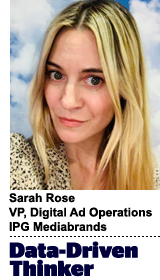
“Data-Driven Thinking” is written by members of the media community and contains fresh ideas on the digital revolution in media.
Today’s column is written by Sarah Rose, vice president of digital ad operations at IPG Mediabrands.
The digital media ecosystem is inherently a marketplace of pixel exchange, where data is captured for audience collection and user-level events, such as clicks, engagements and conversions.
Yet the ecosystem can’t verify that these audiences have been reached or uniformly quantify their quality across mediums. Where most third-party verification vendors provide MRC-accreditation for viewability, brand safety and fraud, audience verification has lagged, largely left behind in bespoke product launches in 2018.
Innovation in audience verification will need to be aligned and subjected to EU’s General Data Protection Regulation (GDPR), California’s Consumer Privacy Act (CCPA) and other regulatory bodies. With first-party data dispersed across CRMs, data management platforms (DMPs) and demand-side platforms, it is difficult to build products that can manage this level of tagging, server-side alignments, opt-in / opt-out mechanisms and reach verification. Our industry needs qualifying ad verification partners to do so.
What are ad verification vendors doing now? There are some differentiations among the industry’s core vendors.
Integral Ad Science (IAS): A notable industry favorite, IAS has robust solutions in viewability, brand safety and ad fraud monitoring and blocking. Its product offerings are strong in most categories, including social environments and programmatic integrations. However, its audience verification solution is tag-based and verifies audiences through third-party partnerships. IAS is not fully integrated into DMP platforms and cannot yet verify first-party data audiences in an opt-in / opt-out solution, though it is prioritizing this for 2019.
DoubleVerify: Best in class, its product has deep integrations with Facebook and social, strong brand safety acumen, viewability and ad fraud blocking. However, its product also lacks an audience verification solution that can capture a first-party data audience, verify it in combination with a DMP, provide reach, quality and ensure that users are GDPR/CCPA-compliant and have opted-in to receive messaging.
MOAT: The only product with a robust audience verification tool because it is owned by Oracle, which has a DMP. It’s not clear from a technical and integration perspective, however, how Oracle’s products interact and overlap. We can assume that there is some overlap, but whether this server-side solution can run an ideal scenario of audience verification across media environments remains an open question.
MOAT is also competitively restricted to only integrate with one DMP – its own. That may or may not limit its scalability and agnostic approach to audience verification. That said, MOAT’s MRC-accredited product line has been developing, and it stealthily launched blocking capabilities for brand safety and fraud without much press in December 2018.
With the rise of audience-based buys and the death of the impression value, agencies and brands are increasingly discussing the need for audience verification tools for media buys. As we innovate the way we reach and capture the user-level value while also honoring user privacy, the digital ecosystem requires a technology set that can align these disparate entities and ensure privacy.
Agencies and brands rely on third-party verification tools to grade media-buy quality and provide feedback on the three pillars of brand safety, viewability and fraud. Let’s look to these vendors to set audience verification as a priority in 2019, and lean on them to create robust and comprehensive solutions through business development, partnerships and proprietary technology innovation.
Follow IPG Mediabrands (@ipgmediabrands) and AdExchanger (@adexchanger) on Twitter.
This post was syndicated from Ad Exchanger.


More Stories
Daily Wire Welcomes Perplexity to Advertise on The Ben Shapiro Show
Here’s the Roundup for the Week Ending March 7
Aflac’s Dan Amos Reveals How He’s Successfully Held Onto the CEO’s Job for 35 Years